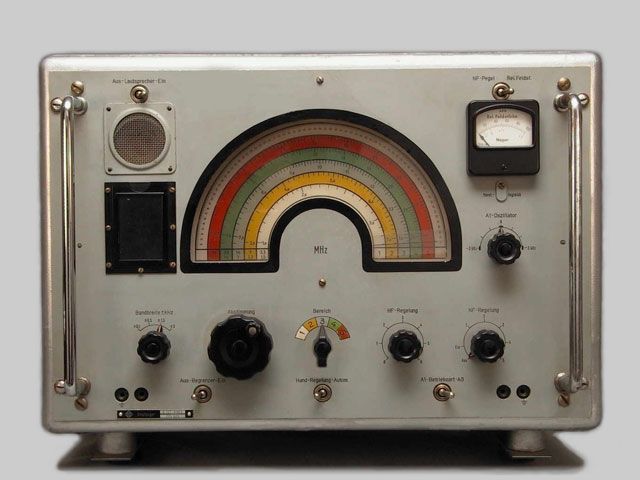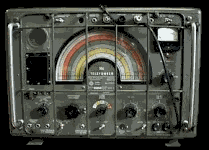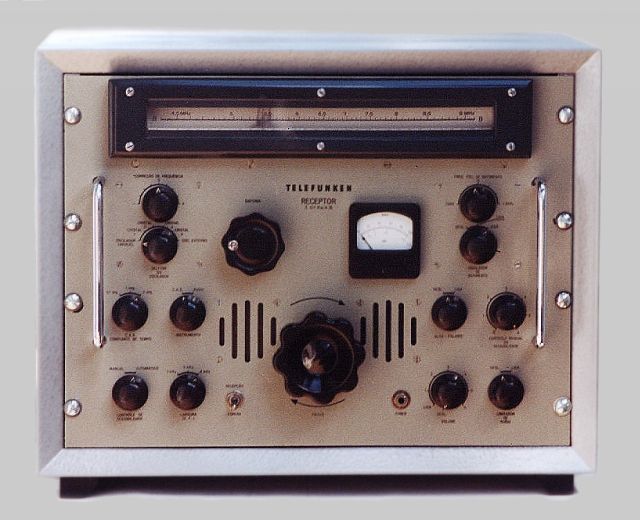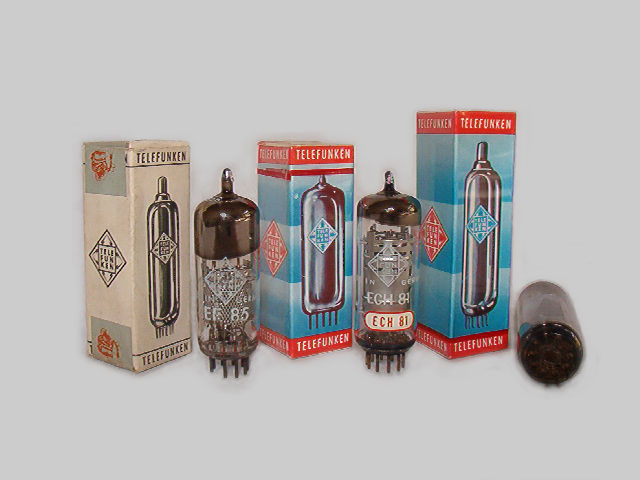
|
|
 |
| Shortwave Communications Receiver |
| Single Conversion Superheterodyne |
| 10 Tubes + Semiconductors |
| Made in West Germany and Brazil 1953 - Midsixties |
| Specifications | |
| Coverage: | 1.5 – 3.3 / 3.2 – 7.1 / 6.9 – 14.1 / 13.9 – 22.1 / 21.9 – 30.5 MHz |
| Modes: | AM/CW/MCW |
| Antenna Input: | HF 4/13 or SO-239 60 Ohms, rod antenna, long wire or loop |
| Sensitivity: | CW: <0.2 µV 6 dB S/N, AM: <2 µV 10 dB S/N |
| Setting & Read out: | 100 kHz marks on dial only, big linear scale 180° with 720 marks, setting accuracy is 5 kHz if interpolation is employed |
| Stability: | 2 x 10-5/°C |
| Selectivity: | 6.3/3.2/1.2/0.3
kHz,
Formfactor -6/-60 dB: 1:2.6 at 6.3 kHz bandwidth |
| IF: | 525 kHz |
| IF Rejection: | > 60 dB, average >80 dB |
| Image Rejection: | > 60 dB below 28 MHz |
| Audio Output: | 2 W for external speaker, 600 Ohms line |
| Voltages: | 110/125/150/220/240 V AC +/-10% 45-60 Hz, 70 W |
| Physical: | Cabinet Version: 550x372x384 mm, 42 kg |
| Rack Version: 520x304x380 mm | |
| Accessories: | Tg Fs 127 for FSK, Abl 127 or Abl 305 for diversity, BP 102 for SSB, Selectojet, fax, built in crystal oscillator with six positions, loop antennas for direction finding. |
| Features | |||
| - Headphone Jack (2) | - Speaker | - Speaker Switch | - Ext. Speaker Jack |
| - Line Out 600 Ohm | - BFO +/-3 kHz | - NL | - S/AF Meter |
| - AGC/MGC | - AGC Output Jack | - Diversity Mode | - IF Output Jack |
| - RF Gain | - Dial Lamps | - Spinner Knob | - Rack Handles |
| - Break In Relais | - Modular Construction | - Measuring Points | - Six Fixed Freq. Pos. |
| Circuit Complement |
| Two RF amplifier stages EF 85 (=6 BY 7), main oscillator and mixer ECH 81 (=6 AJ 8), five RF circuits, ganged variable capacitors are driven by a spinner knob, in pushed position 4:1 for scanning of large frequency ranges, in pulled position 110:1 for fine tuning. Crystal oscillator EL 84 (=6 BQ 5), two IF Amplifiers EF 85, 1st and 2nd IF filters each with a 525 kHz crystal protected by a biased germanium diode. AGC amplifier EF 85, BFO and product detector ECH 81, AF amplifier EL 84, voltage regulator 150 C 2 (=0 A 2). Rectifiers in IF stages, NL and for meter are germanium diodes; selenium rectifiers in power supply. |
| Comments |
| A very robustly built receiver designed for government and other public or commercial authorities. Main monitoring receiver for HF of the German Army at the Eastern Border in the sixties. Also used for point to point connections and shore operation with crystal oscillator until the 80’s in the CW, FAX and RTTY mode. One of the last receivers where frequency setting had to be done by interpolation between 100 kHz marks. As the tuning gears are smooth and reliable, 5 kHz setting is possible, if position on the linear scale is registered in a logbook. The receiver is very calm and sensible (low noise tubes, biased AGC and reduced amplifying in RF stages, just one conversion). Although using just one conversion image rejection is >60 dB (a result of four good circuits in RF Amp). Selectivity is good for AM (Formfactor at 6.3 kHz is 1:2.6 (-6/-60 dB)) and very good for CW. SSB reception is fine too as there is a product-detector as used in all Telefunken receivers from 1953 on. The E 127 Kw is called the "Rainbow Receiver". It is very popular with nostalgic SW listeners and collectors. This receiver is a fine single conversion receiver like RCA AR-88 and RBC or Telefunken "Main" and "Köln". Competitors were Hagenuk UE 11, Lorenz E 5 and Siemens E 303 – E 309. |
| Variants |
| Model E 127 Kw/2 (1953) is very similar to E 103 Aw/4 but didn't have the LF/MF-ranges. E 127 Kw/4 is the commercial version and has a light gray front panel and cabinet. E 127 Kw/4 B was produced by Telefunken in Brazil and has a big dial drum instead of the "Rainbow". The E 127 Kw/5 is the military version. It has a dark green front panel and all connectors are on the front panel, which is protected by a metal grid. Instead of high quality electrolytic capacitors long life MP-capacitors could be ordered. |
| Additional Information |
Block diagram of the E 127 Kw/5 (click to enlarge).
The following photo shows the military version of the E 127 (E 127 Kw/5).

This is the Brazil version of the E 127 (E 127 Kw/4 B).

The type of tubes used in the E 127 (Noval tubes).
